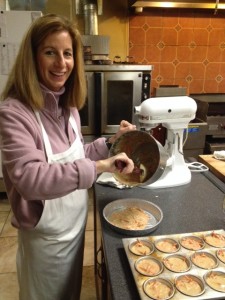A couple Saturdays ago, I spent the morning at a pastry class with my husband. This experience was out of my comfort zone. I grew up in a home with a mother who prepared all meals for our family, and I married someone who not only wants to do the cooking, but is good at it. The years in between were filled with a diet consisting of frozen dinners, cereal, and ice cream. But this was a gift from me to him – something to do together – so I was game.
As someone who didn’t know that cooking was different from baking (they both happen in the kitchen and involve the oven), I admittedly struggled. But it was fun, casual, and involved a patient pastry chef. We made different cookies, cakes, and breads. We used machines. We learned from the instructor and each other. And we went home with lots of delicious treats to eat and share.
When I brought some to work, one of my team members asked, “So, can you follow a recipe now?” After a brief hesitation, I said, “Probably not.”
It’s not that I can’t follow instructions. But what I realized in class is that the terminology and tools are completely foreign to me. Within the first five minutes of class, another participant asked if we were going to “proof the yeast”. Huh? Who knew that “cream” was a verb? How do you add ingredients “in stages”? What’s a “drying agent”? Should residents have “hotel pans”? What makes a good piping bag? When do you make the leap from a single boiler to a double? When we were making the bread, we had to knead it. Now THAT I had heard of, although I didn’t know the technique. The helpful chef showed me how to flatten, *fold*, push, pat, etc. Not too difficult… I was baking!
Later, we were making meringue. The recipe called for us to *fold* powdered sugar into the bowl of ingredients. Well, I had just learned how to fold dough. I looked into the bowl of goop and asked skeptically, “You want me to put my hands in there?”
My husband edged away, pretending he didn’t know me.
I can follow software installation instructions. Reading an article on scheduling techniques doesn’t leave me scratching my head. Teaching project management concepts is a natural exercise. I’ve been educated and immersed in technology and project management, so the terminology and tools don’t make me curdle like overheated milk. But it’s important to remember that everyone I work with may not be as familiar. Defining terms, spelling out acronyms, demonstrating tools, and introducing common industry methodologies is a valuable practice.
Take the time at the beginning of assignments to understand your colleagues’ language and tools, and share yours. What are common terms used by Communications staff? What tools do Materials Management folks use? Which approaches do Learning & Organizational Development experts consider? How does Finance define various budget items? Starting from a common framework on projects with these teams benefits everyone. Teaching and learning some profession basics can save time and avoid misunderstanding.
That way, you might not find yourself staring frightfully at a Kitchen Aid, not knowing how to turn it on, let alone knowing when your mixture is “frothy”, “emulsified”, and “light”.


Thank you for sharing your experience, and the lesson you have learned. I consider myself a good cook, but I married someone who is professionally trained in the food industry. I totally understand what you have gone through.
I can relate! My team speaks in acronyms. To this day, I have to stop and ask for definitions every once in awhile! During my first week at Dana-Farber 4 years ago, I was taking notes at a meeting, and someone said, “we should present this to ark”. In the meeting minutes I wrote – “present to ARK.” I was later politely informed that ARK is actually AHRQ (i.e., Agency for Healthcare Research and Quality). Who knew!? p.s. GREAT PIC! looks fun! 🙂
Victor – We are lucky w/ our spouses, aren’t we?!
Jen – Acronymns are the WORST. Until you know them. Then they’re the BEST. 😉